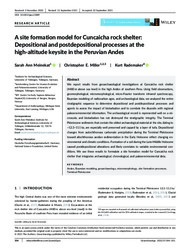A site formation model for Cuncaicha rock shelter: Depositional and postdepositional processes at the high‐altitude keysite in the Peruvian Andes
DOI: https://doi.org/10.1002/gea.21889
Persistent URL: http://resolver.sub.uni-goettingen.de/purl?gldocs-11858/9783
Persistent URL: http://resolver.sub.uni-goettingen.de/purl?gldocs-11858/9783
Meinekat, Sarah Ann; Miller, Christopher E.; Rademaker, Kurt, 2021: A site formation model for Cuncaicha rock shelter: Depositional and postdepositional processes at the high‐altitude keysite in the Peruvian Andes. In: Geoarchaeology, Band 37, 2: 304 - 331, DOI: 10.1002/gea.21889.
 |
Dokument öffnen: |
We report results from geoarchaeological investigations at Cuncaicha rock shelter (4480 m above sea level) in the high Andes of southern Peru. Using field observations, geomorphological, micromorphological, micro‐Fourier transform infrared spectroscopy, Bayesian modeling of radiocarbon ages, and archaeological data, we analyzed the entire stratigraphic sequence to determine depositional and postdepositional processes and agents to assess the impact of bioturbation and to correlate the deposits with regional paleoenvironmental information. The archaeological record is represented well on a microscale, and bioturbation has not destroyed the stratigraphic integrity. The Terminal Pleistocene sediments that contain the oldest archaeological material at the site, dating to ~12.3–11.1 ka, are especially well preserved and capped by a layer of tufa. Depositional changes from autochthonous carbonate precipitation during the Terminal Pleistocene toward allochthonous aeolian sedimentation in the Early Holocene reflect changing environmental and climatic conditions. Formation of a soil during the Late‐Middle Holocene caused postdepositional alterations and likely correlates to variable environmental conditions. We use these results to formulate a site formation model for Cuncaicha rock shelter that integrates archaeological, chronological, and paleoenvironmental data.
Statistik:
ZugriffsstatistikSammlung:
- Geologie [930]
Schlagworte:
AndesBayesian modeling
geoarchaeology
micromorphology
site formation processes
Terminal Pleistocene
This is an open access article under the terms of the Creative Commons Attribution‐NonCommercial‐NoDerivs License, which permits use and distribution in any medium, provided the original work is properly cited, the use is non‐commercial and no modifications or adaptations are made.

